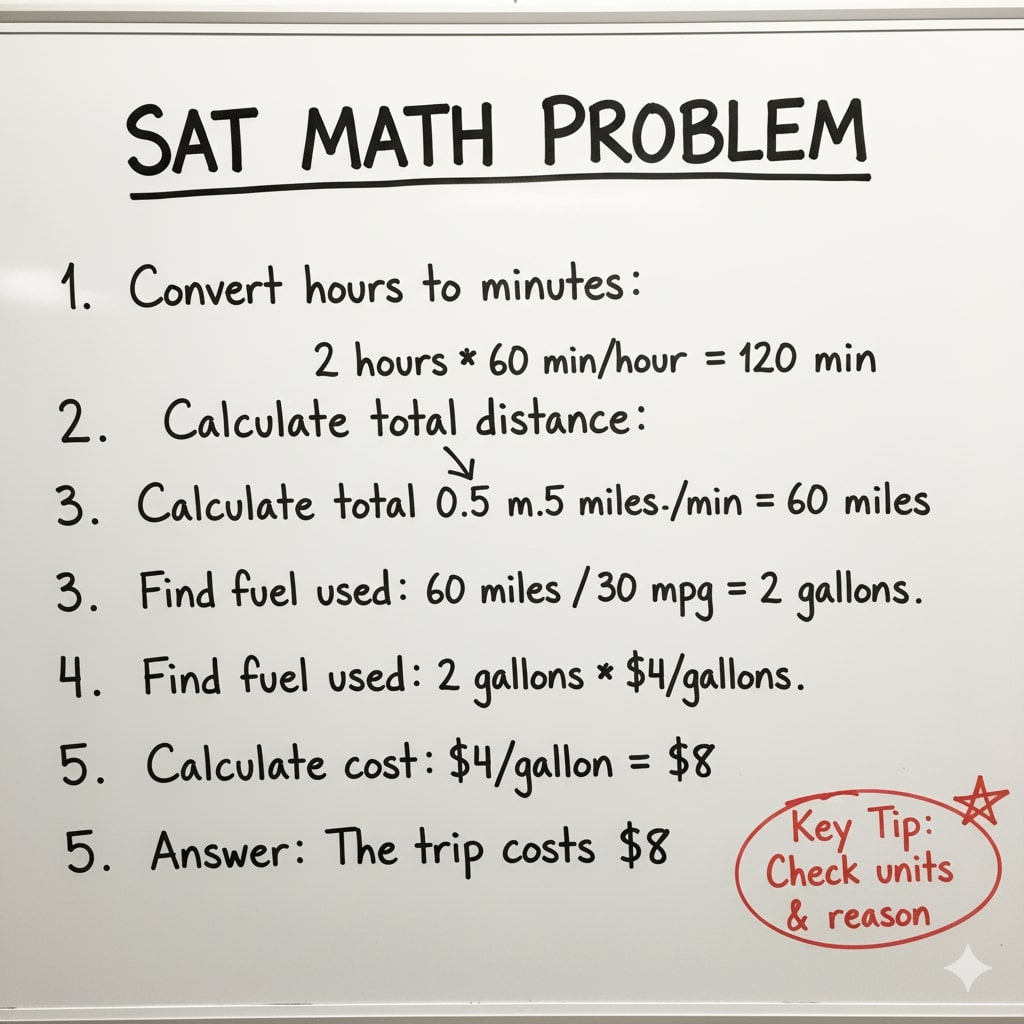Why your school math matters more than you think
If you’ve ever sat in math class and wondered, “Will I actually use this on the SAT?” — the short answer is: yes. The digital SAT focuses on math areas that high schools teach because those skills are useful in college and career settings. But the way math appears on the test is also a little different from classroom quizzes: it asks for applied reasoning, efficient strategies, and clear use of foundational concepts. This post unpacks the bridge between what your teacher covers and what the SAT wants, and gives you a practical, student-friendly plan to turn classroom knowledge into SAT points.
What the SAT math section actually tests
The digital SAT organizes math questions across categories that probably look familiar from school: Algebra, Advanced Math (often built from algebraic ideas), Problem‑Solving & Data Analysis, and Geometry & Trigonometry. Questions range from routine calculations to multi-step problem solving set in real-world contexts—so it’s not just about memorizing formulas; it’s about using them.
Four core categories — what to expect
- Algebra: Linear equations, systems, manipulating expressions, and interpreting functions. These are the backbone of school algebra classes.
- Advanced Math: Polynomial manipulation, quadratic reasoning, functional notation, and the kind of algebra that prepares you for precalculus.
- Problem‑Solving & Data Analysis: Ratios, percentages, proportional reasoning, interpreting graphs and tables — these are often tied to real data or context passages.
- Geometry & Trigonometry: Plane geometry, area/volume, and basic trig ideas like sine/cosine relationships in right triangles.
How classroom skills map to SAT skills — a quick translation guide
Think of school math as the raw material and the SAT as the craft challenge. Teachers give you concepts, notation, and practice problems; the SAT tests your ability to choose the right tool, adapt methods to new contexts, and manage time. Here’s a short translation table that shows common classroom topics and how they’re used on the SAT.
| School Topic | What the SAT Looks For | Study Focus |
|---|---|---|
| Simplifying expressions | Quick manipulation to reduce algebraic complexity | Techniques for factoring and combining like terms under time pressure |
| Solving linear equations | Translating word problems into equations and solving | Setting variables sensibly and checking for extraneous solutions |
| Functions and graphs | Interpreting slope, intercept, and function notation in context | Reading graphs fast and linking algebraic form to graphical features |
| Ratios and proportions | Scaling, unit conversions, and data‑driven reasoning | Cross-multiplication, dimensional analysis, and estimation |
| Geometry proofs/angles | Applying theorems rather than writing full formal proofs | Memorize key facts and practice visualizing problems |
Real classroom habits that translate to better SAT scores
Beyond content, your habits matter. The SAT is timed and adaptive; your fluency, error rate, and strategy choices determine how well school knowledge converts into SAT points. Here are practical habits to cultivate now.
1. Make quick conceptual checks a habit
When you solve a problem in class, pause for one second and ask: “Why does this method work?” That little check trains you to reason under time pressure. On the SAT, you’ll often benefit from a two‑second conceptual glance before diving into calculations — it helps avoid common mistakes.
2. Practice explaining solutions in plain language
Try writing a one‑sentence explanation of your solution after you solve a classroom problem: “I set x to be the number of miles, then used rate*time to get …” This builds clarity of thought and prevents algebraic leaps that can lead to careless errors on the test.
3. Embrace number sense and estimation
Teachers often emphasize exact answers; the SAT rewards quick, reasonable estimates too. Use estimation to eliminate unlikely choices or check whether a full calculation is worth the time.
4. Work with context problems regularly
Many SAT math questions are framed as real‑world scenarios. Practice translating sentences into equations: treat classroom word problems as training for the SAT’s context questions.
Strategies for each SAT math category
Algebra
Mastery tip: Be fluent with manipulating expressions and solving linear systems. If a question looks messy, ask whether substitution or elimination makes it simpler. Practice rewriting expressions so you spot hidden factors fast.
Advanced Math
Mastery tip: Recognize patterns — perfect squares, differences of squares, and common quadratic structures. Learn how to read function notation and use it confidently. For polynomials, practice quick factor checks and plugging in small values to test possible roots.
Problem‑Solving & Data Analysis
Mastery tip: Be comfortable with units and conversions, and always look for the most direct path from data to answer. Read tables and graphs actively: identify the variable names, units, and what the axes represent before you calculate.
Geometry & Trig
Mastery tip: Draw accurate sketches even if the test provides a diagram. Label known angles and sides; a short, neat figure often reveals a shortcut. Memorize a handful of formulas (area, circumference, volume, special right triangles) but focus on reasoning with them.
Study plan: turning a semester of school math into 8 weeks of SAT gains
This plan assumes you’re learning math in school right now and have eight weeks until a practice digital SAT or test date. It blends classroom work with targeted SAT practice so you don’t waste time relearning basics.
- Week 1–2: Audit & foundation
- Identify weak spots from recent quizzes (algebra, geometry, etc.).
- Take one official digital practice module to establish a baseline.
- Create a short list of formulas, rules, and vocabulary you must recall instantly.
- Week 3–4: Focused skill blocks
- Spend 3 days on algebra techniques (manipulation, functions), 2 days on problem‑solving and data, 2 days on geometry/trig.
- Do targeted practice sets of 8–12 questions and time yourself.
- Week 5–6: Mixed practice & strategy
- Take two full-length digital practice tests spaced a week apart.
- Analyze every missed question. Was it content, careless error, or time management?
- Week 7: Simulation & polish
- Run a full test in Bluebook or the official practice app under test conditions.
- Practice time‑saving strategies: plugging in answer choices, backsolving, estimation.
- Week 8: Targeted review & calm
- Review your top 10 recurring error types and make a one‑page cheat sheet to glance at daily.
- Get sleep, light exercise, and short review sessions rather than cramming.
Examples and mini walk‑throughs
Seeing how a classroom concept becomes a test question is helpful. Below are two short examples that show the bridge between schoolwork and SAT problems.
Example 1: From linear equations to a quick solve
Class problem: Solve 3x + 5 = 20. SAT flavor: A company’s revenue is modeled by R(x) = 3x + 5, and net revenue reaches $20k—how many units x were sold? The method is the same: isolate x. The SAT twist is context; labeling variables clearly (units sold, dollars) keeps your work organized and avoids sign mistakes.
Example 2: Geometry shortcut
Class problem: Find the area of a triangle with base 6 and height 4. SAT flavor: A diagram shows a triangle inside a rectangle, with a portion shaded and a few side lengths given. Instead of recomputing from scratch, use area relationships: if the triangle is half the rectangle’s height or shares a base, you can reuse known rectangle area. These small observations save time.
Common pitfalls students bring from school math — and how to fix them
- Overreliance on one method: In class you might always expand polynomials; on the SAT sometimes factoring or plugging in numbers is faster. Fix: practice multiple approaches and recognize when each is efficient.
- Careless arithmetic errors: Schools often give partial credit; the SAT does not. Fix: adopt quick checks—rounding or inverse operations—to confirm your result.
- Misreading contexts: In class you might be told explicitly what variable means. On the SAT, define variables yourself and restate the question in a short phrase before solving.
- Panic under time pressure: Timed quizzes are different from a 3‑hour test. Fix: simulate test conditions, learn to triage questions, and use estimation to skip time‑consuming traps.

How to practice efficiently — not just harder
Quality practice beats quantity. Here’s an effective routine you can steal and adapt:
- Warm up with 10 minutes of mental math or flash recall of formulas.
- Do a focused 30‑minute block on one skill (e.g., systems of equations) with immediate review.
- Finish with 20 minutes of mixed practice to train switching between topics.
After each session, log the two things you missed and why. This little reflection dramatically reduces repeated mistakes.
Tools that make classroom-to-SAT transfer easier
Official digital practice tools mimic the testing environment. Combine those with targeted paper practice and small group or one‑on‑one support when you need more structure. If you find yourself repeatedly stuck on the same kinds of questions, personalized tutoring—like Sparkl’s 1‑on‑1 guidance—can identify the root cause and design a tailored study plan. Tutors can model efficient strategies, give instant feedback, and use AI‑driven insights to prioritize topics that yield the biggest score gains.
Sample weekly tracking table
Use this simple table as a template to monitor your progress. Record what you practiced, errors, and a short plan for improvement.
| Week | Focus | Practice Used | Top 2 Errors | Action Items |
|---|---|---|---|---|
| 1 | Algebra foundations | Class sets + 1 Bluebook module | Variable mislabel, sign error | Slow down first step; verbalize variable meaning |
| 2 | Functions & graphs | Graph reading exercises | Axis misread, unit mismatch | Annotate axes; rewrite units |
| 3 | Data analysis | Table problems | Wrong ratio, rounding mistake | Use proportional set-up; estimate sanity check |
 When to get extra help — and what to ask for
When to get extra help — and what to ask for
Most students benefit from extra help at specific moments: when a concept refuses to click after repeated study, when recurring errors persist, or when efficiency under time pressure is the bottleneck. If you choose tutoring, target sessions at:
- Diagnosing the single largest source of wrong answers (concept vs. careless error).
- Developing a personalized timing strategy—what to skip, what to guess, and what to double‑check.
- Creating a short daily drill that aligns with your classroom schedule and test timeline.
Sparkl’s personalized tutoring can be especially useful when you want one‑on‑one guidance to translate classroom practice into test strategies, or to receive AI‑driven insights that highlight the high‑impact skills you should focus on.
Final tips to build confidence before test day
- Two weeks out: stop learning new content; focus on polished practice and recovery habits.
- Night before: light review of a one‑page list of formulas and two calming breathing exercises.
- Test morning: a simple protein snack, a brief mental warm-up with 5–10 math problems, and a checklist of pencils, charger, and ID for the test app environment.
- During the test: label variables, estimate before heavy computation, and keep moving. If a problem stalls you for more than a minute, mark it and come back.
Parting thought: your classwork is your advantage
School math and SAT math are not separate worlds — they’re on the same road. Classroom learning gives you the vocabulary and foundation; the SAT asks you to apply that knowledge quickly, accurately, and in context. By refining habits (quick conceptual checks, smart estimation, clean variable definitions), practicing under realistic conditions, and using targeted help when needed, you can convert everyday school success into measurable SAT gains. If you ever feel stuck, remember that a tailored approach—whether a focused study plan you build with a teacher or the personalized 1‑on‑1 support provided by a tutoring program like Sparkl—can accelerate progress and make the journey less stressful.
Keep practicing with purpose, celebrate small improvements, and treat every missed question as a clue. Your schoolwork has already given you most of the tools; the SAT just asks you to use them with confidence.
















No Comments
Leave a comment Cancel